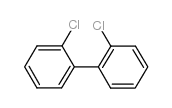2,2'-DICHLOROBIPHENYL

2,2'-DICHLOROBIPHENYL structure
|
Common Name | 2,2'-DICHLOROBIPHENYL | ||
|---|---|---|---|---|
| CAS Number | 13029-08-8 | Molecular Weight | 223.09800 | |
| Density | 1.249g/cm3 | Boiling Point | 289.1ºC at 760mmHg | |
| Molecular Formula | C12H8Cl2 | Melting Point | 79-80℃ (hexane ) | |
| MSDS | Chinese USA | Flash Point | 122.4ºC | |
| Symbol |


GHS08, GHS09 |
Signal Word | Warning | |
| Name | 2,2'-Dichlorobiphenyl |
|---|---|
| Synonym | More Synonyms |
| Density | 1.249g/cm3 |
|---|---|
| Boiling Point | 289.1ºC at 760mmHg |
| Melting Point | 79-80℃ (hexane ) |
| Molecular Formula | C12H8Cl2 |
| Molecular Weight | 223.09800 |
| Flash Point | 122.4ºC |
| Exact Mass | 222.00000 |
| LogP | 4.66040 |
| Vapour Pressure | 0.00389mmHg at 25°C |
| Index of Refraction | 1.594 |
CHEMICAL IDENTIFICATION
HEALTH HAZARD DATAACUTE TOXICITY DATA
|
| Symbol |


GHS08, GHS09 |
|---|---|
| Signal Word | Warning |
| Hazard Statements | H373-H410 |
| Precautionary Statements | P273-P391-P501 |
| Personal Protective Equipment | dust mask type N95 (US);Eyeshields;Gloves |
| Hazard Codes | N: Dangerous for the environment; |
| Risk Phrases | R33 |
| Safety Phrases | S35 |
| RIDADR | UN 2315 |
| RTECS | DV3900000 |
| Packaging Group | II |
|
Structural characterization of Pandoraea pnomenusa B-356 biphenyl dioxygenase reveals features of potent polychlorinated biphenyl-degrading enzymes.
PLoS ONE 8(1) , e52550, (2013) The oxidative degradation of biphenyl and polychlorinated biphenyls (PCBs) is initiated in Pandoraea pnomenusa B-356 by biphenyl dioxygenase (BPDO(B356)). BPDO(B356), a heterohexameric (αβ)(3) Rieske ... |
|
|
Possible molecular targets of halogenated aromatic hydrocarbons in neuronal cells.
Biochem. Biophys. Res. Commun. 280(5) , 1372-7, (2001) Halogenated aromatic hydrocarbon including polychlorinated biphenyls (PCBs) are persistent and bioaccumulative environmental toxicants. Although health effects associated with exposure to these chemic... |
|
|
Comparative toxicokinetics of 2,2'- and 4,4'-dichlorobiphenyls in the pond snail Lymnaea stagnalis (L.).
Arch. Environ. Contam. Toxicol. 19(4) , 565-71, (1990) Pond snails (Lymnaea stagnalis (L.)) were treated with 2,2'-dichlorobiphenyl (DCB) or 4,4'-DCB, to examine the toxicokinetic profile of these compounds. Snails were treated orally with 210 micrograms ... |
| 1-chloro-2-(2-chlorophenyl)benzene |

